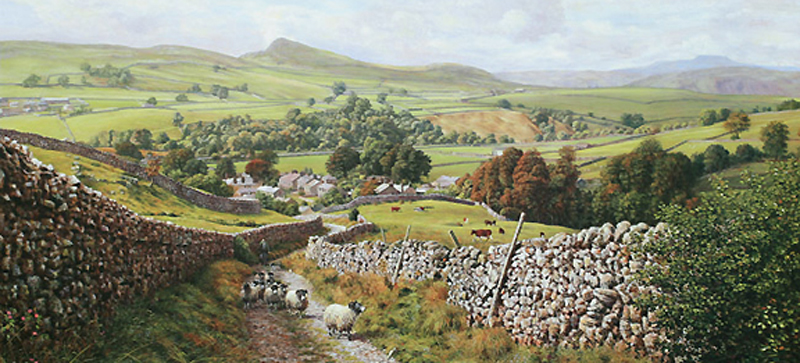

Travellers to the Shire often describe it as a land of gentle green hills and well-tilled fields. Most travellers, of course, trudge along the old Dwarven causeway or flit through its southern woodlands. Few venture into North Farthing to explore its spectacular high moors and deep dales. Here, land changes from soft chalk to hard limestone and rises steadily to a steep sill marking the northern boundary of the Shire. North farthing has many moods: it can be wild and windswept, or quietly tranquil. Silent and snowbound at Yule, or full of boisterous merrymaking at Mid-Lithe. It includes the finest scenery in the Shire, from limestone crags and caves to winding rivers and spectacular waterfalls. Stone-built villages sit amongst traditional farming landscapes of field barns, drystone walls and flower-rich hay meadows in the lower dales. Higher still are more isolated settlements, with upland ash and oak woodlands on the valley sides and moor top bog and heathland.
Life in North Farthing is tougher than elsewhere in the Shire. This is partly due to the lack of through trade, partly due to the scarcity of arable soil, and partly due to icy northern winds which can sweep in at any time. Hobbits here are proud of their resilience and have a strong community spirit. Of their drawbacks, they have a way of speaking their mind very plainly; you always know exactly where you are with them. However their most strong characteristic is their practicality. With enough time, the right tools, and an absence of interesting risk, a North Farthing hobbit can fettle just about anything (leastways enough to be going on with).
Farming in North Farthing is deeply traditional and change is made cautiously, if at all. Pastures and arable land are worked in common by each community with fields planted with rye or wheat, oats or barley, or left fallow in a four year rotation rather than the three usual elsewhere. Naturally the brewing of ale is a speciality of the dales. However the main wealth of the farthing undoubtedly comes from its many flocks of sheep which are grazed on the high moors during summer. These Old Horndale sheep produce both good wool and good meat and, if you can catch ‘em, good milk. Cheese is a particular delicacy although not everyone is enamoured of the ‘cave ripened’ blue varieties. A small number of cattle are kept in the east of the farthing where they can be grazed in the Greenfield orchards during summer.
This saga takes place towards the end of the Third Age, over a number of years during the events described in the Red Book of Undertowers, but from a more reliable perspective than that narrated by the Mad Bagginses. This is what really happened…
